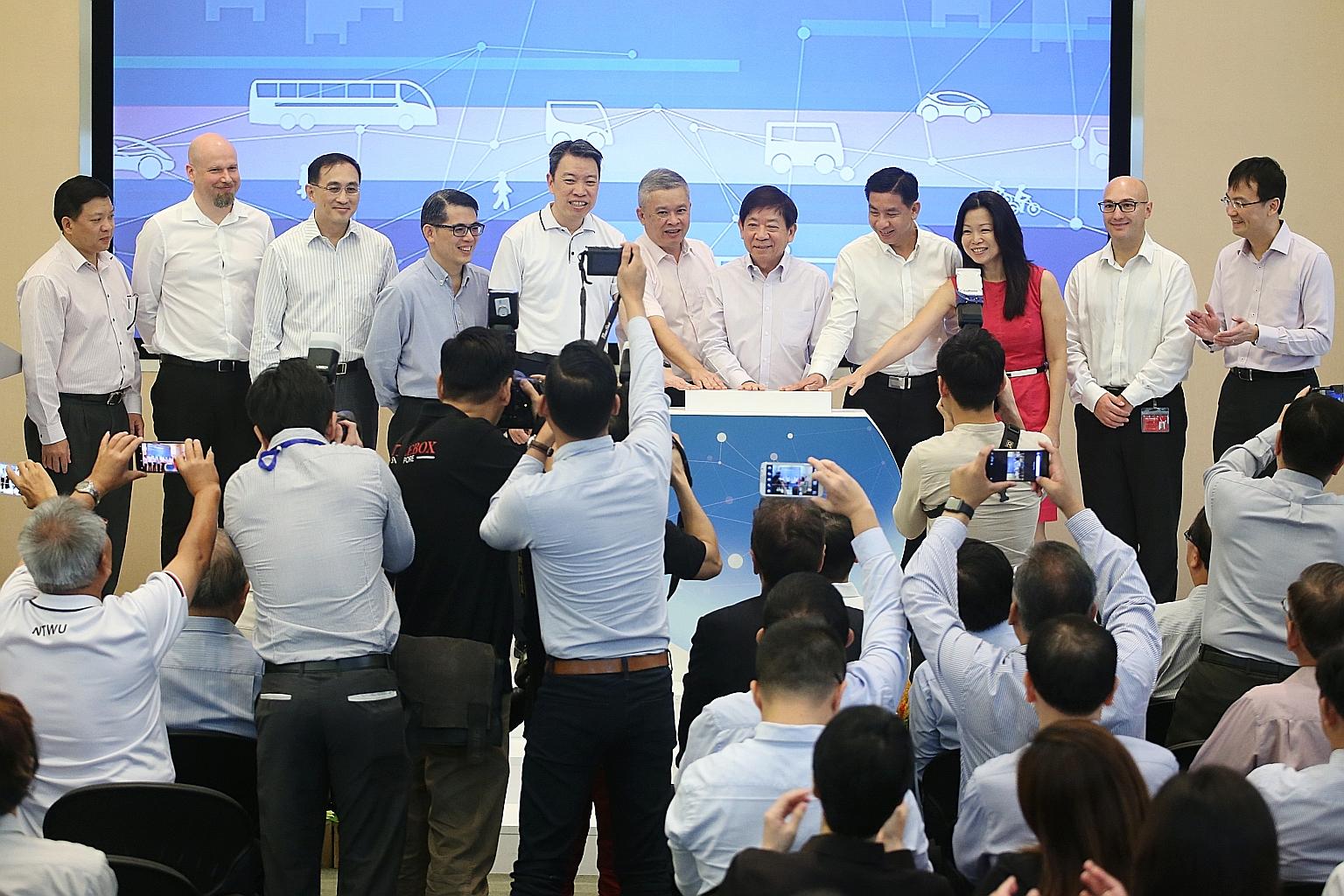Road map to help land transport sector prepare for change
Sign up now: Get ST's newsletters delivered to your inbox

Transport Minister and Coordinating Minister for Infrastructure Khaw Boon Wan (seventh from left) and transport officials launching the Land Transport Industry Transformation Map yesterday at the PSA Building.
PHOTO: LIANHE ZAOBAO
Follow topic:
The Land Transport Authority (LTA) will set aside $25 million over five years to kick-start mobility-related research and trials for the land transport industry - a sector which will create 8,000 new jobs by 2030.
Transport Minister Khaw Boon Wan said yesterday that the Land Transport Innovation Fund will include collaborative projects between the LTA and local industry partners such as ST Kinetics.
He said the government-linked company is working on autonomous robot movers - which move heavy components needed for rail maintenance - for train depots. It is also looking at augmented reality devices for railway training, maintenance and inspection.
Speaking at the launch of the Land Transport Industry Transformation Map, Mr Khaw said the land transport industry has to be "technology ready, workforce ready and ecosystem ready".
In a sector where developments like driverless vehicles could take away jobs, Mr Khaw also said a land transport industry transformation map was being developed to prepare workers for new roles.
He said the industry currently employs 123,000 people, with 21,000 in the bus and rail sectors. The bulk of the remainder are private-hire and taxi drivers.
"With the expansion of our public bus and rail systems, we expect the current workforce of 21,000 to grow by 8,000 new jobs by 2030," he said, adding that technology will create more jobs for professionals, managers, executives and technicians.
-
Plans at a glance
• LTA to partner agencies such as IE Singapore, Spring Singapore and the Economic Development Board to develop a land transport industry transformation map.
• LTA to set aside $25 million over five years for mobility-related research and trials for the land transport industry.
• Future-proof 123,000 land transport workers, with headcount growing by 8,000 from now until 2030.
• Upskilling and reskilling workers to be done at institutes of higher learning and academies such as the Singapore Bus Academy and Singapore Rail Academy.
• A Public Transport Skills Framework, to be launched in May, to help workers better visualise where they are headed with the new skills they are acquiring.
"To ensure that our public transport workers keep pace with industry development, we will upskill workers, and reskill them," the minister said.
The Singapore Bus Academy and Singapore Rail Academy, whose courses have benefited more than 2,200 participants to date, will help with this effort.
A Public Transport Skills Framework has been developed to provide "a clear pathway" for skills upgrading and mastery. To be launched in May, it will help workers see where their new skills may take them.
The minister said the industry contributes to about 1.1 per cent of Singapore's gross domestic product, but "the wider economic and intangible benefits from enhanced connectivity are much higher".
He noted that the Government has spent more than $28 billion since 2013 on the public tran-sport system, and that more than 5,000 people have joined the bus and rail sectors. Another 40,000 have become private-hire car drivers since 2013.
The LTA, beyond its traditional role of planner and regulator, will partner agencies such as IE Singapore, Spring Singapore and the Economic Development Board to develop the land transport industry transformation map, he added.
In his blog yesterday, National Transport Workers' Union executive secretary Melvin Yong said he had been losing sleep over the eventual arrival of driverless vehicles that might take away driving jobs. But he said the Land Transport Industry Transformation Map will "hopefully... help me sleep better".
He said the plan should "prepare and transition workers through these changes with ease, at the same time develop and build a workforce that is well-equipped to take on future and higher-value jobs".
SBS Transit senior engineer Alvin Lim, 49, told The Straits Times that using technology to monitor the condition of the North East MRT line has resulted in more accurate assessments as well as better working conditions.
"Previously, we had to do everything manually, set up scaffolding in the tunnels, and technicians worked from a height," he said. "It was labour-intensive, and we combed the line in three-month cycles."
But with the Catenary Eye and Video Monitoring System, the state of the train power-supply system is monitored "live", and the staff are alerted via SMS when there are anomalies.
"Machines also seldom make mistakes," Mr Lim said, explaining that this meant "more objective and reliable" monitoring.

